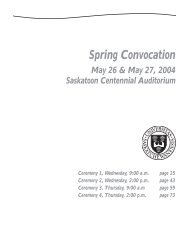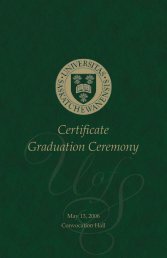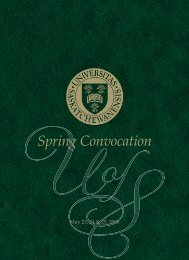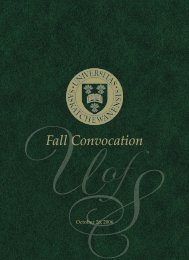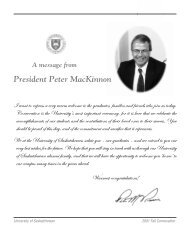Spring Convocation - Students - University of Saskatchewan
Spring Convocation - Students - University of Saskatchewan
Spring Convocation - Students - University of Saskatchewan
Create successful ePaper yourself
Turn your PDF publications into a flip-book with our unique Google optimized e-Paper software.
A pioneer in nuclear physics research<br />
In 1999, the <strong>University</strong> <strong>of</strong> <strong>Saskatchewan</strong> learned it would be home to the largest scientific project ever undertaken in Canada: the<br />
Canadian Light Source (CLS). The announcement generated a great deal <strong>of</strong> excitement about the <strong>University</strong>’s future as a world leader in<br />
research and synchrotron science. But it is important to note that the building <strong>of</strong> the CLS and the selection <strong>of</strong> our campus as its home<br />
were not random events, but the result <strong>of</strong> a series <strong>of</strong> historic developments on campus.<br />
The Department <strong>of</strong> Physics early on had built for itself a<br />
reputation based upon experimentation and innovation.<br />
The post-war period saw the U <strong>of</strong> S in the forefront <strong>of</strong><br />
nuclear physics in Canada.<br />
In 1948, Canada’s first betatron (and the world’s first used<br />
in the treatment <strong>of</strong> cancer) was installed on campus. It was<br />
used for research programs in nuclear physics, radiation<br />
chemistry, cancer therapy and radiation biology. Next the<br />
world’s first non‐commercial cobalt-60 therapy unit for the<br />
treatment <strong>of</strong> cancer was <strong>of</strong>ficially opened in 1951.<br />
With this unit research was undertaken in the areas <strong>of</strong><br />
radiological physics, radiation chemistry and the effects <strong>of</strong><br />
high energy radiation on plants and animals.<br />
When the construction <strong>of</strong> the Linear Accelerator (Linac)<br />
was announced in the fall <strong>of</strong> 1961, it was portrayed as the<br />
next logical step on the <strong>University</strong>’s research path. The<br />
80-foot electron accelerator tube was to create energy six<br />
times that <strong>of</strong> the betatron.<br />
Open House at the Linear Accelerator on campus, Nov. 8, 1964. A-8643<br />
The cost <strong>of</strong> the $1,750,000 Linac facility was split between<br />
the National Research Council and the <strong>University</strong> <strong>of</strong><br />
<strong>Saskatchewan</strong>, with the NRC meeting the cost <strong>of</strong> the<br />
equipment and the <strong>University</strong> assuming the costs <strong>of</strong> the<br />
building.<br />
The <strong>of</strong>ficial opening in early November <strong>of</strong> 1964 was more<br />
than just a few speeches and the cutting <strong>of</strong> a ribbon. It was<br />
a physics‐fest, with 75 visiting scientist from around the<br />
world in attendance presenting papers and giving lectures<br />
over the period <strong>of</strong> several days. Three eminent physicists<br />
were granted honorary degrees at the Fall <strong>Convocation</strong> and<br />
hundreds <strong>of</strong> people showed up for the public open house.<br />
Patrick Hayes<br />
<strong>University</strong> <strong>of</strong> <strong>Saskatchewan</strong> Archives<br />
The staff <strong>of</strong> Canadian Light Source Inc. on the experimental hall floor,<br />
February 2006. Photo courtesy Canadian Light Source Inc., <strong>University</strong> <strong>of</strong> <strong>Saskatchewan</strong>.



